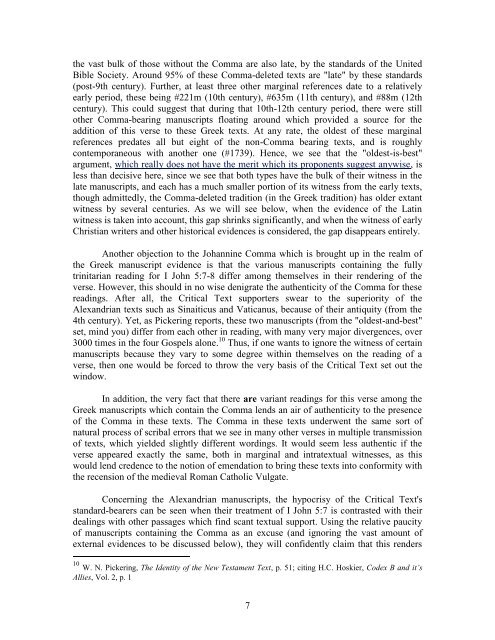A Defense of the Johannine Comma - Study to Answer.Net
A Defense of the Johannine Comma - Study to Answer.Net
A Defense of the Johannine Comma - Study to Answer.Net
Create successful ePaper yourself
Turn your PDF publications into a flip-book with our unique Google optimized e-Paper software.
<strong>the</strong> vast bulk <strong>of</strong> those without <strong>the</strong> <strong>Comma</strong> are also late, by <strong>the</strong> standards <strong>of</strong> <strong>the</strong> United<br />
Bible Society. Around 95% <strong>of</strong> <strong>the</strong>se <strong>Comma</strong>-deleted texts are "late" by <strong>the</strong>se standards<br />
(post-9th century). Fur<strong>the</strong>r, at least three o<strong>the</strong>r marginal references date <strong>to</strong> a relatively<br />
early period, <strong>the</strong>se being #221m (10th century), #635m (11th century), and #88m (12th<br />
century). This could suggest that during that 10th-12th century period, <strong>the</strong>re were still<br />
o<strong>the</strong>r <strong>Comma</strong>-bearing manuscripts floating around which provided a source for <strong>the</strong><br />
addition <strong>of</strong> this verse <strong>to</strong> <strong>the</strong>se Greek texts. At any rate, <strong>the</strong> oldest <strong>of</strong> <strong>the</strong>se marginal<br />
references predates all but eight <strong>of</strong> <strong>the</strong> non-<strong>Comma</strong> bearing texts, and is roughly<br />
contemporaneous with ano<strong>the</strong>r one (#1739). Hence, we see that <strong>the</strong> "oldest-is-best"<br />
argument, which really does not have <strong>the</strong> merit which its proponents suggest anywise, is<br />
less than decisive here, since we see that both types have <strong>the</strong> bulk <strong>of</strong> <strong>the</strong>ir witness in <strong>the</strong><br />
late manuscripts, and each has a much smaller portion <strong>of</strong> its witness from <strong>the</strong> early texts,<br />
though admittedly, <strong>the</strong> <strong>Comma</strong>-deleted tradition (in <strong>the</strong> Greek tradition) has older extant<br />
witness by several centuries. As we will see below, when <strong>the</strong> evidence <strong>of</strong> <strong>the</strong> Latin<br />
witness is taken in<strong>to</strong> account, this gap shrinks significantly, and when <strong>the</strong> witness <strong>of</strong> early<br />
Christian writers and o<strong>the</strong>r his<strong>to</strong>rical evidences is considered, <strong>the</strong> gap disappears entirely.<br />
Ano<strong>the</strong>r objection <strong>to</strong> <strong>the</strong> <strong>Johannine</strong> <strong>Comma</strong> which is brought up in <strong>the</strong> realm <strong>of</strong><br />
<strong>the</strong> Greek manuscript evidence is that <strong>the</strong> various manuscripts containing <strong>the</strong> fully<br />
trinitarian reading for I John 5:7-8 differ among <strong>the</strong>mselves in <strong>the</strong>ir rendering <strong>of</strong> <strong>the</strong><br />
verse. However, this should in no wise denigrate <strong>the</strong> au<strong>the</strong>nticity <strong>of</strong> <strong>the</strong> <strong>Comma</strong> for <strong>the</strong>se<br />
readings. After all, <strong>the</strong> Critical Text supporters swear <strong>to</strong> <strong>the</strong> superiority <strong>of</strong> <strong>the</strong><br />
Alexandrian texts such as Sinaiticus and Vaticanus, because <strong>of</strong> <strong>the</strong>ir antiquity (from <strong>the</strong><br />
4th century). Yet, as Pickering reports, <strong>the</strong>se two manuscripts (from <strong>the</strong> "oldest-and-best"<br />
set, mind you) differ from each o<strong>the</strong>r in reading, with many very major divergences, over<br />
3000 times in <strong>the</strong> four Gospels alone. 10 Thus, if one wants <strong>to</strong> ignore <strong>the</strong> witness <strong>of</strong> certain<br />
manuscripts because <strong>the</strong>y vary <strong>to</strong> some degree within <strong>the</strong>mselves on <strong>the</strong> reading <strong>of</strong> a<br />
verse, <strong>the</strong>n one would be forced <strong>to</strong> throw <strong>the</strong> very basis <strong>of</strong> <strong>the</strong> Critical Text set out <strong>the</strong><br />
window.<br />
In addition, <strong>the</strong> very fact that <strong>the</strong>re are variant readings for this verse among <strong>the</strong><br />
Greek manuscripts which contain <strong>the</strong> <strong>Comma</strong> lends an air <strong>of</strong> au<strong>the</strong>nticity <strong>to</strong> <strong>the</strong> presence<br />
<strong>of</strong> <strong>the</strong> <strong>Comma</strong> in <strong>the</strong>se texts. The <strong>Comma</strong> in <strong>the</strong>se texts underwent <strong>the</strong> same sort <strong>of</strong><br />
natural process <strong>of</strong> scribal errors that we see in many o<strong>the</strong>r verses in multiple transmission<br />
<strong>of</strong> texts, which yielded slightly different wordings. It would seem less au<strong>the</strong>ntic if <strong>the</strong><br />
verse appeared exactly <strong>the</strong> same, both in marginal and intratextual witnesses, as this<br />
would lend credence <strong>to</strong> <strong>the</strong> notion <strong>of</strong> emendation <strong>to</strong> bring <strong>the</strong>se texts in<strong>to</strong> conformity with<br />
<strong>the</strong> recension <strong>of</strong> <strong>the</strong> medieval Roman Catholic Vulgate.<br />
Concerning <strong>the</strong> Alexandrian manuscripts, <strong>the</strong> hypocrisy <strong>of</strong> <strong>the</strong> Critical Text's<br />
standard-bearers can be seen when <strong>the</strong>ir treatment <strong>of</strong> I John 5:7 is contrasted with <strong>the</strong>ir<br />
dealings with o<strong>the</strong>r passages which find scant textual support. Using <strong>the</strong> relative paucity<br />
<strong>of</strong> manuscripts containing <strong>the</strong> <strong>Comma</strong> as an excuse (and ignoring <strong>the</strong> vast amount <strong>of</strong><br />
external evidences <strong>to</strong> be discussed below), <strong>the</strong>y will confidently claim that this renders<br />
10 W. N. Pickering, The Identity <strong>of</strong> <strong>the</strong> New Testament Text, p. 51; citing H.C. Hoskier, Codex B and it’s<br />
Allies, Vol. 2, p. 1<br />
7


